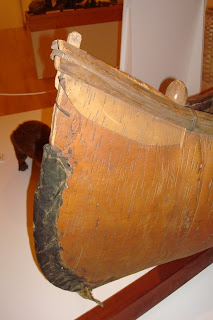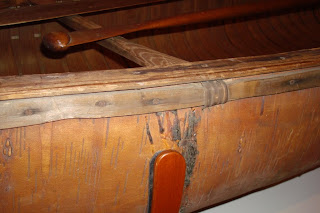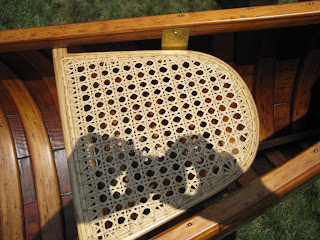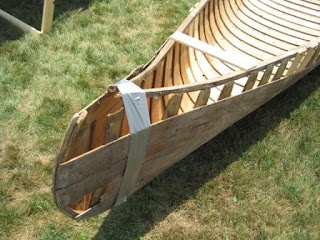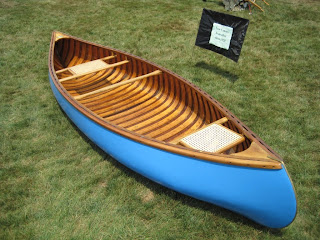We've all heard it said – said so often that it's a truism – that boatbuilders and sailors are conservative. When I came across such statements in two of my most recent reads, however, I gave it some thought, as all truisms deserve. And while it may be true in a limited sense, I now say that, by and large, it's nonsense, and it's time we stopped perpetuating the myth of maritime conservatism.
The first instances appeared in
The boat beneath the pyramid: King Cheops' royal ship
, by Nancy Jenkins. She writes, "Boatbuilders, we have already noted, are extraordinarily conservative by nature, and their basic principles have remained much the same throughout the millennia that men and women have been putting to sea."
Now, Jenkins seems to be a pretty fair journalist, but not a serious student of boat origins, so perhaps we can forgive her for merely parroting the truism of conservatism that she picked up somewhere – perhaps from a learned source, perhaps not. (By the way, I can't find the previous allusion to conservatism that she refers to, but that might be her editor's sin, and not hers. There are subsequent mentions of it, and perhaps her editor moved things around.) But her statement in its context just doesn't hold water. The "basic principles" of boatbuilding, whether viewed over the millennia or across the globe, are quite diverse. Even in the context of her own book, she notes that the earliest Egyptian boats were papyrus reed floats and that, by the time of King Cheops, wooden boats existed alongside them.
Right there, we see two entirely different concepts of boatbuilding, side by side in a historical venue. The reed-bundle vessel floats because it is composed entirely of buoyant materials. The planked boat floats according to a different principle, by displacing water. Some centuries, possibly millennia, before Cheops had his ship built around 2600 BC, some boatbuilder came by this innovation by an incredible leap of intellect. And many of his colleagues saw the advantages of his new technology and copied it – hardly a conservative response. This is more especially so when one considers that boatbuilding lumber was unavailable in Egypt and had to be imported at great cost from what is now Lebanon, requiring that new trade routes and relationships be established.
And as for the boatbuilders who persisted in making reed boats (or, properly, rafts)? Those boats remained practical: cheap and easily built of materials available locally (possibly free), requiring far less specialized skill and few if any specialized tools. For anyone below the level of a noble, and for any purpose other than war, ceremony, or international trade, the reed boat remained not only practical, but in all probability, the only type available. In a very limited sense of the word, this might be termed "conservative," in that it retained an old practice. But there is no reason to think that the builders and users of these reed boats did do so out of any predisposition toward old ways; they did it out of pragmatism. And conservatism is not pragmatic: it is predisposed to the past on emotional or ideological grounds. When circumstances change, the conservative resists changing his methods.
Let's get back to Jenkins' assertion about the basic principles of boatbuilding remaining nearly unchanged. In addition to the reed raft and the plank-built hull constructed in the ancient Egyptian manner, pre-industrial boatbuilding methods included:
• skin boats
• log rafts
• rafts supported by inflated skins or by pottery vessels
• bark canoes
• dugouts and their variants
• numerous other plank-building methods
The list is not exhaustive, but it should suffice to disprove the notion that boatbuilding methods are, or were in antiquity, limited or static.
Paul Johnstone, in
The Sea-Craft of Prehistory
, also addresses the development of the papyriform wooden boat in Egypt. He notes how the long bow overhang, which is a natural feature of a reed boat, was also a practical feature on the Nile, where the boat could be run up on the shore for ease of loading and unloading dry-shod. He continues:
"Perhaps, however, it was found in time that while the overhang forward was convenient, it was safer if the after extremity was curved up to give some protection when running before the wind. Since reed structures are not self-supporting like wooden ones, the simplest way to achieve rigidity was to bend the aftermost reed bundle as far forward as it would go and then lash it to the hull. Such is the conservatism of sailors and ship-builders (a factor that runs constantly through this book), that this stern bent over toward the bow survived in the Mediterranean right through Greek and Roman times and even in recent Venetian small craft." [The parenthetical phrase is Johnstone's.]
It is hard to see the conservatism that Johnstone asserts. If the raised stern provided protection to Egyptian helmsmen even on the calm and protected Nile, surely it provided the same advantages to Greek and Roman helmsmen on the open Mediterranean – in addition, possibly, to protecting them from the arrows of pirates or other enemies.
Assembling a model of Cheops' ship. The blades that support the decorative stempost are shown clearly. (Photo from Jenkins)
The Cheops ship being reassembled. The huge, hollow stem piece is shown directly below the blades over which it will be fitted. (Photo from Jenkins)
Mounting the tall, raised stem- and sternposts on papyriform wooden ships involved some special engineering, given the boats' long overhangs and the weight of those decorative appendages. Planks were added that extended several feet beyond the enclosed hull fore and aft, forming "wings" over which the stem and sternpost were socketed. While we have few artifacts to prove it, I think it certain that the first wooden boats devised by Egyptian boatwrights did not have the papyriform shape, the challenge of creating the first wooden displacement hull from first principles presenting more than enough difficulties for any one boat project. If we agree that the first Egyptian wooden boat must have been fairly simple in shape, then the papyriform hull, with its special features to support the soaring stem- and sternposts, must have been a later innovation. Far from being a holdover from earlier reed-building practice (and it could not have been that, the methods of construction being too entirely different between reed boats and timber hulls to allow any direct transfer of methods), the papyriform ends were a conscious replication or mimicry of the reed boat's shape for symbolic purposes. This was technical innovation in boatbuilding in the service of what may have been a conservative aesthetic or religious impulse.
Johnstone later describes the Portuguese beach boats known as
saveiros or
xavegas, and what he calls their "smaller southern brother, the
meia lua." (We discussed the
xavega in a
previous post.) Noting the types' distinctive design and construction details (flat bottom, extreme sheer and extremely high ends, keelless construction over frames), he cites T.C. Lethbridge, who in 1952 suggested that the types were quite ancient, and possibly ancestors of the ancient planked vessels of Celtic influence found in England and northern Europe (such as the Blackfriars ship). Johnstone writes:
[Lethbridge] supported this thesis by pointing out the important difference between beach and estuary boats. Beach craft always face a specific situation – through the breakers from a flat shore. A suitable form for this, with a flat bottom and at least one high extremity to face the breaking waves, could have been evolved many centuries ago and survive in a remarkably unvaried shape, except occasionally for the stern, from Gibraltar to Cape Wrath. No such conservatism was forced on the estuary boatman. He had no surf to worry about and no limitation on launching weight or depth of keel. Moreover, he had sheltered water in which to try out new ideas and these again might be stimulated by seeing strangers and visiting craft who would seek shelter on occasion in an estuary or inlet, whereas they would never except in an emergency run ashore on an open beach. Saveiros are launched from beaches into the open Atlantic on wooden rollers by oxen pushing on a wooden fork against the stern post, and Lethbridge's theory of beach conservatism indicates that they may be an ancient design. Shortage of resources, isolation and the need to be absolutely certain of the performance of their craft in the open Atlantic would perpetuate this conservatism."

A saveiro. Just visible at the right is the business end of the forked pole against the sternpost. Oxen push against the other end of the pole to launch the boat. (Photo from Johnstone.)
The logic here is mostly backwards. No fisherman would have risked launching and landing through Atlantic breakers without some strong motivation – such as being excluded from the safer estuaries by competition. Boats for calm estuaries, therefore, preceded the
saveiro, and these estuary boats quickly proved themselves unequal to the challenge – and hence they evolved out of necessity, gaining high ends and perhaps internal frames in the process. It is the
saveiro, therefore, that demonstrates innovation. If the design be an ancient one, that is because it is also a good one. One cannot know how many attempted "improvements" on the
saveiro proved to be less well-suited to conditions, but surely many such attempts were made before the boats' users decided to let well enough alone. Again, this is not conservatism, but pragmatism.
Read any history of Western boat- and shipbuilding, and one sees constant change, constant divergence into new types. Look at a survey of the vessels of any large region or country (some examples:
Canoes of Oceania (Special Publications - Bernice P. Bishop Museum; 27-29)
, Haddon & Hornell;
American Small Sailing Craft
, Chapelle;
Working Boats of Britain
, McKee;
The Junks and Sampans of the Yangtze
, Worcester), and one finds an amazing number and variety of types, each one of which evolved for some particular purpose or in response to some unusual factor of sea conditions.
Finally, view boatbuilding against nearly any other complex endeavor that has persisted for millennia, and boatbuilding comes out looking positively dynamic. Did architecture, agriculture, or government change more dramatically than boatbuilding over the centuries? Did the wheeled vehicle, or infantry tactics, or road building evolve further and into a greater number of directions? Has religion been more adaptive to changing circumstances? (LOL) With the coming of the industrial revolution and, later, of modern science, was boatbuilding behindhand in adopting new forms of propulsion, new materials, the benefits of microprocessor technology?
On the contrary. Boatbuilding has always been notably innovative. It's time to put the old "boatbuilding is conservative" myth to rest. Next time you hear it, speak up.





